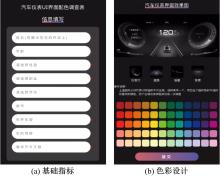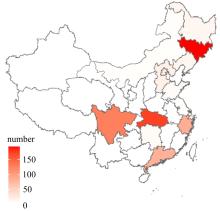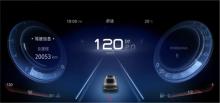吉林大学学报(工学版) ›› 2023, Vol. 53 ›› Issue (5): 1315-1321.doi: 10.13229/j.cnki.jdxbgxb.20230188
• 车辆工程·机械工程 • 上一篇
无人驾驶汽车智能座舱人机交互界面色彩设计
- 1.中国一汽集团股份有限责任公司 CAV发展研究院,长春 130062
2.吉林大学 汽车工程学院,长春 130022
Color design of human⁃computer interaction interface for intelligent cockpit of unmanned vehicle
Hui ZHANG1( ),Zhi-ling NIE1,Hong-wei XIAO2,Dan-xing WANG1(
),Zhi-ling NIE1,Hong-wei XIAO2,Dan-xing WANG1( )
)
- 1.CAV Development Research Institute,China FAW Group Corporation,Changchun 130062,China
2.College of Automotive Engineering,Jilin University,Changchun 130022,China
摘要:
通过对汽车人机交互界面(HMI)系统配色评价研究提高显示界面的用户体验度。针对不同人群对颜色偏好的机制,提出了3个关于人们颜色偏好的假设,然后进行了一项众包调查。实验结果采用描述性统计和卡方检验,比较不同组在界面的4个部分的颜色选择。结果表明:油量标志的选择以红色系为主,背景色彩、仪表灯及道路显示均以蓝色系和绿色系为主;不同性别和不同地区的居民的颜色偏好也有显著差异;警示部分推荐使用暖色系,而其他部分推荐使用冷色系;多种界面配色方案都有利于满足不同的用户需求。
中图分类号:
- U46
| 1 | 李彦龙, 高想, 张晔峰. 基于消费者心理的汽车色彩偏好量化研究[J]. 设计, 2019, 32(20): 110-112. |
| Li Yan-long, Gao Xiang, Zhang Ye-feng, et al.Research on quantitative method of automobile color selection based on Consumer psychology[J]. Design, 2019, 32(20): 110-112. | |
| 2 | 古大治. 色彩与图形视觉原理色彩与图形视觉原理:关于看的艺术与科学[M].北京: 科学出版社, 2000. |
| 3 | 赵晨音. UI用户界面色彩设计研究[J]. 流行色, 2017(12): 112-117. |
| Zhao Chen-yin. Research on color design of UI user interface[J]. Fashion Colour, 2017(12): 112-117. | |
| 4 | 许向阳. 与视觉认知过程相关的图像色貌建模的研究[D]. 广州: 华南理工大学轻工科学与工程学院, 2016. |
| Xu Xiang-yang. A research of image color appearance modeling based on cognition processing of human vision[D]. Guangzhou: School of Light Industry and Engineering, South China University of Technolgy, 2016. | |
| 5 | 冯剑红, 李国良, 冯建华. 众包技术研究综述[J]. 计算机学报, 2015, 38(9): 1713-1726. |
| Feng Jiang-hong, Li Guo-liang, Feng Jian-hua.A survey on crowd sourcing[J]. Chinese Journal of Computers, 2015, 38(9): 1713-1726. | |
| 6 | von Hippel E. Democratizing innovation: the evolving phenomenon of user innovation[J]. Journal Fur Betriebswirtschaft, 2005, 55: 63-78. |
| 7 | Manav B. Color-emotion associations and color preferences: a case study for residences[J]. Color Research and Application, 2007, 32(2): 144-150. |
| 8 | Fortmann-Roe S. Effects of hue, saturation, and brightness on color preference in social networks: gender-based color preference on the social networking site Twitter[J]. Color Research & Application, 2013, 38(3): 196-202. |
| 9 | Hurlbert A C, Ling Y. Biological components of sex differences in color preference[J]. Current Biology, 2007, 17(16): 623-625. |
| 10 | Guan S S, Huang P S. Influences of psychological factors on image color preferences evaluation[J]. Color Research & Application, 2010, 35(3): 213-232. |
| 11 | Hanada M. Correspondence analysis of color-emotion associations[J]. Color Research & Application, 2018, 43(2): 224-237. |
| 12 | Manav B. Color-emotion associations and color preferences: a case study for residences[J]. Color Research & Application, 2007, 32(2): 144-150. |
| 13 | Hines M, Pasterski V, Spencer D, et al. Prenatal androgen exposure alters girls responses to information indicating gender-appropriate behaviour[J]. Philosophical Transactions of the Royal Society of London. Series B, Biological Sciences, 2016, 371(1688): 20150125. |
| 14 | Wang S F, Ding R. A qualitative and quantitative study of color emotion using valence-arousal[J]. Frontiers of Computer Science, 2012, 6(4): 469‒476. |
| 15 | 王平, 杨君顺, 高晋. 色彩心理学在产品设计中的应用[J]. 轻工机械, 2008, 92(2): 5-7. |
| Wang Ping, Yang Jun-shun, Gao Jin. The application of color psychology in product design[J]. Light Industry Machinery, 2008, 92(2): 5-7. |
| [1] | 张勇,毛凤朝,刘水长,王青妤,潘神功,曾广胜. 基于Laplacian算法的汽车外流场畸变网格优化[J]. 吉林大学学报(工学版), 2023, 53(5): 1289-1296. |
| [2] | 陈鑫,张冠宸,赵康明,王佳宁,杨立飞,司徒德蓉. 搭接焊缝对铝合金焊接结构轻量化设计的影响[J]. 吉林大学学报(工学版), 2023, 53(5): 1282-1288. |
| [3] | 汪少华,储堃,施德华,殷春芳,李春. 基于有限时间扩张状态观测的HEV鲁棒复合协调控制[J]. 吉林大学学报(工学版), 2023, 53(5): 1272-1281. |
| [4] | 陈磊,王杨,董志圣,宋亚奇. 一种基于转向意图的车辆敏捷性控制策略[J]. 吉林大学学报(工学版), 2023, 53(5): 1257-1263. |
| [5] | 李胜,朱佳,黄德惠,陈存福,费洪庆,丰伟,胡兴军. 空冷中冷器百叶窗翅片结构参数优化[J]. 吉林大学学报(工学版), 2023, 53(4): 998-1006. |
| [6] | 谢波,高榕,许富强,田彦涛. 低附着路况条件下人车共享转向系统稳定控制[J]. 吉林大学学报(工学版), 2023, 53(3): 713-725. |
| [7] | 高松,王玉琼,王玉海,徐艺,周英超,王鹏伟. 智能汽车纵横向整体反馈线性化控制[J]. 吉林大学学报(工学版), 2023, 53(3): 735-745. |
| [8] | 张建,刘金波,高原,刘梦可,高振海,杨彬. 基于多模交互的车载传感器定位算法[J]. 吉林大学学报(工学版), 2023, 53(3): 772-780. |
| [9] | 何科,丁海涛,赖宣淇,许男,郭孔辉. 基于Transformer的轮式里程计误差预测模型[J]. 吉林大学学报(工学版), 2023, 53(3): 653-662. |
| [10] | 何科,丁海涛,许男,郭孔辉. 基于摄像头和车道线的增强定位系统[J]. 吉林大学学报(工学版), 2023, 53(3): 663-673. |
| [11] | 朱冰,范天昕,赵健,张培兴,孙宇航. 基于危险边界搜索的自动驾驶系统加速测试方法[J]. 吉林大学学报(工学版), 2023, 53(3): 704-712. |
| [12] | 罗瑞发,郝慧君,徐桃让,顾秋凡. 考虑智能网联车队强度的混合交通流基本图模型[J]. 吉林大学学报(工学版), 2023, 53(2): 405-412. |
| [13] | 王登峰,陈宏利,那景新,陈鑫. 单双搭接接头经高温老化后的失效对比[J]. 吉林大学学报(工学版), 2023, 53(2): 346-354. |
| [14] | 彭浩楠,唐明环,查奇文,王伟忠,王伟达,项昌乐,刘玉龙. 自动驾驶汽车双车道换道最优轨迹规划方法[J]. 吉林大学学报(工学版), 2022, 52(12): 2852-2863. |
| [15] | 余剑武,陈亚玲,范光辉,胡仕港,包有玉. 锂电池并行流道液冷板结构设计和散热性能分析[J]. 吉林大学学报(工学版), 2022, 52(12): 2788-2795. |
|
||











